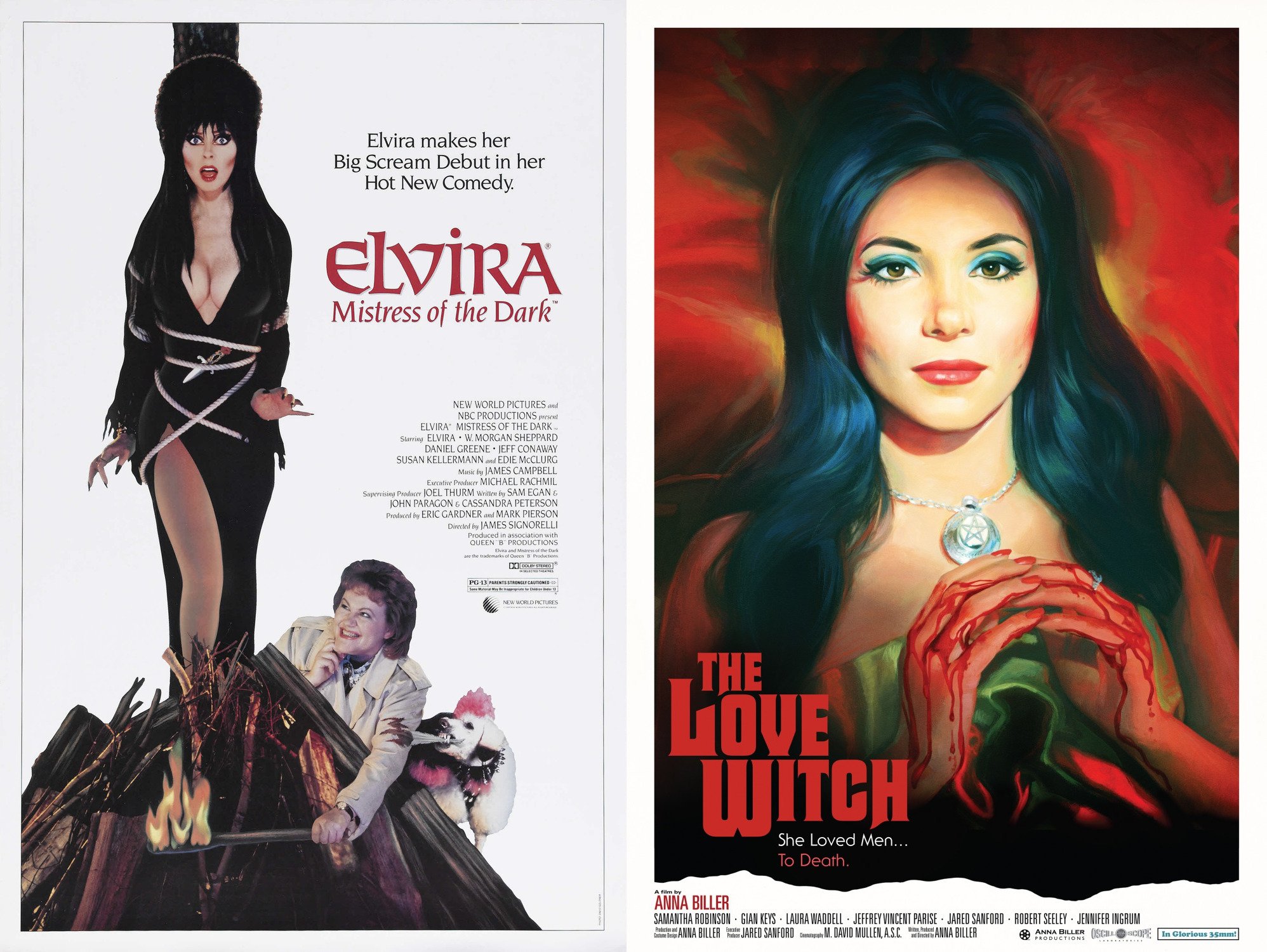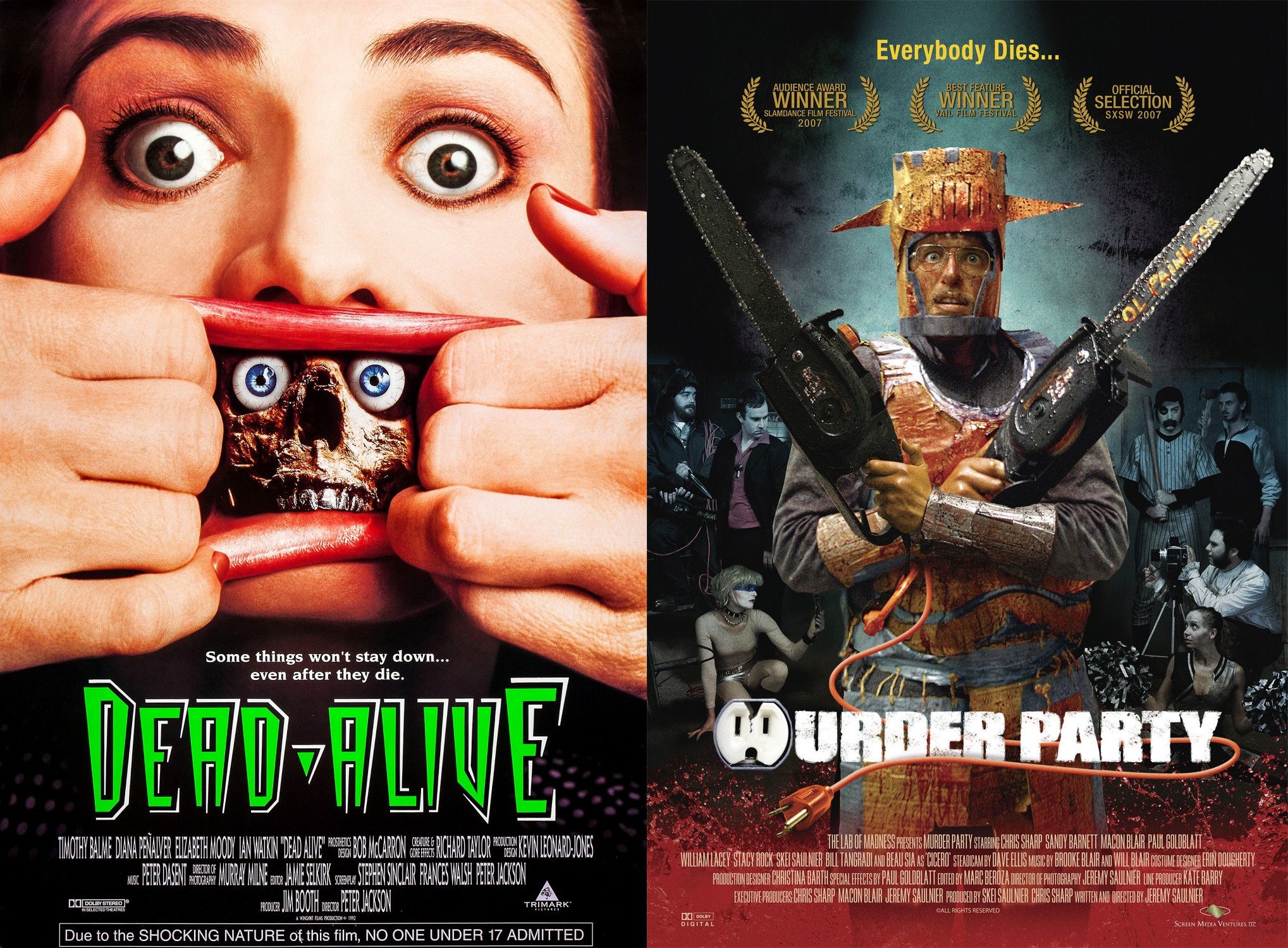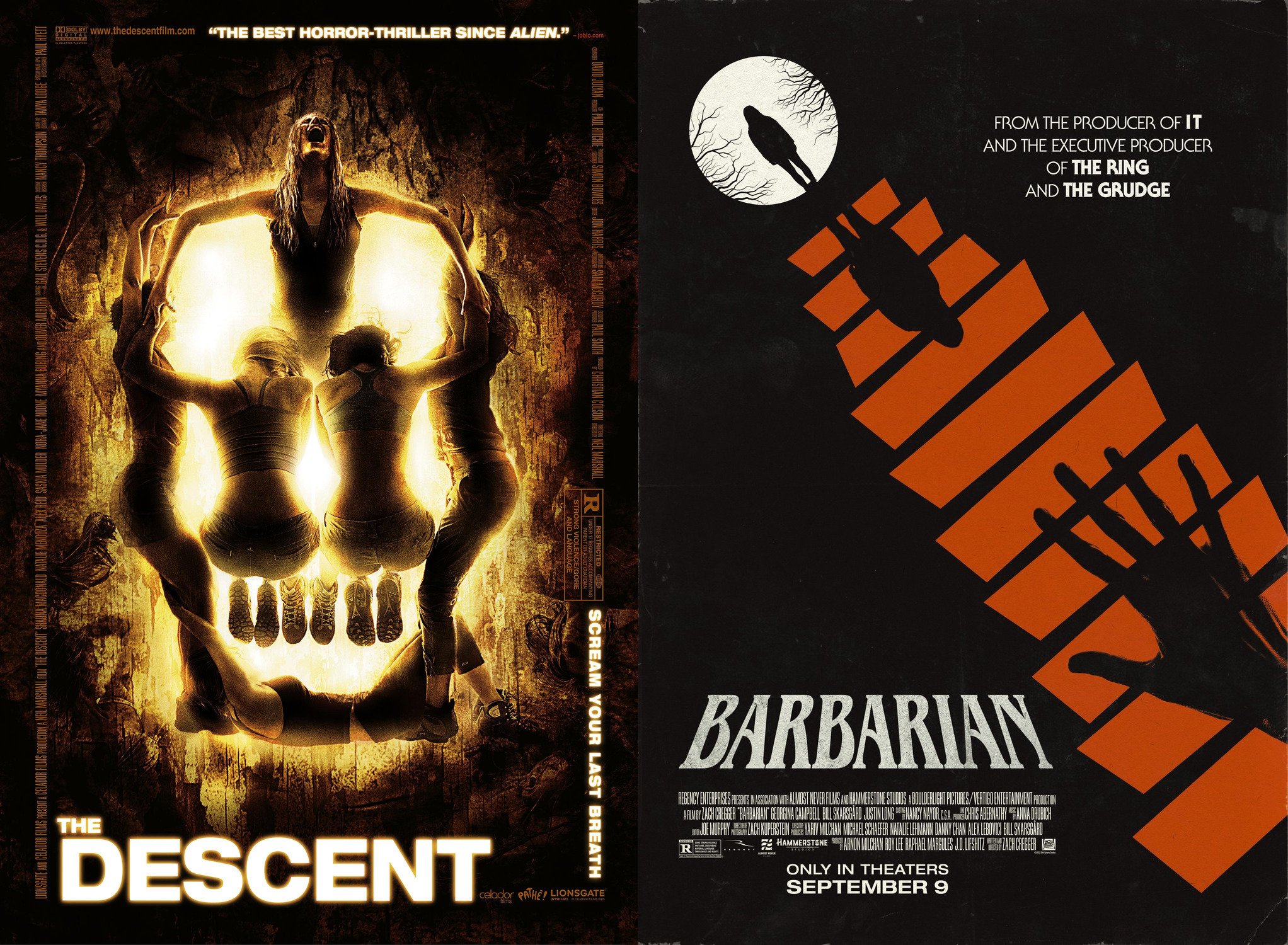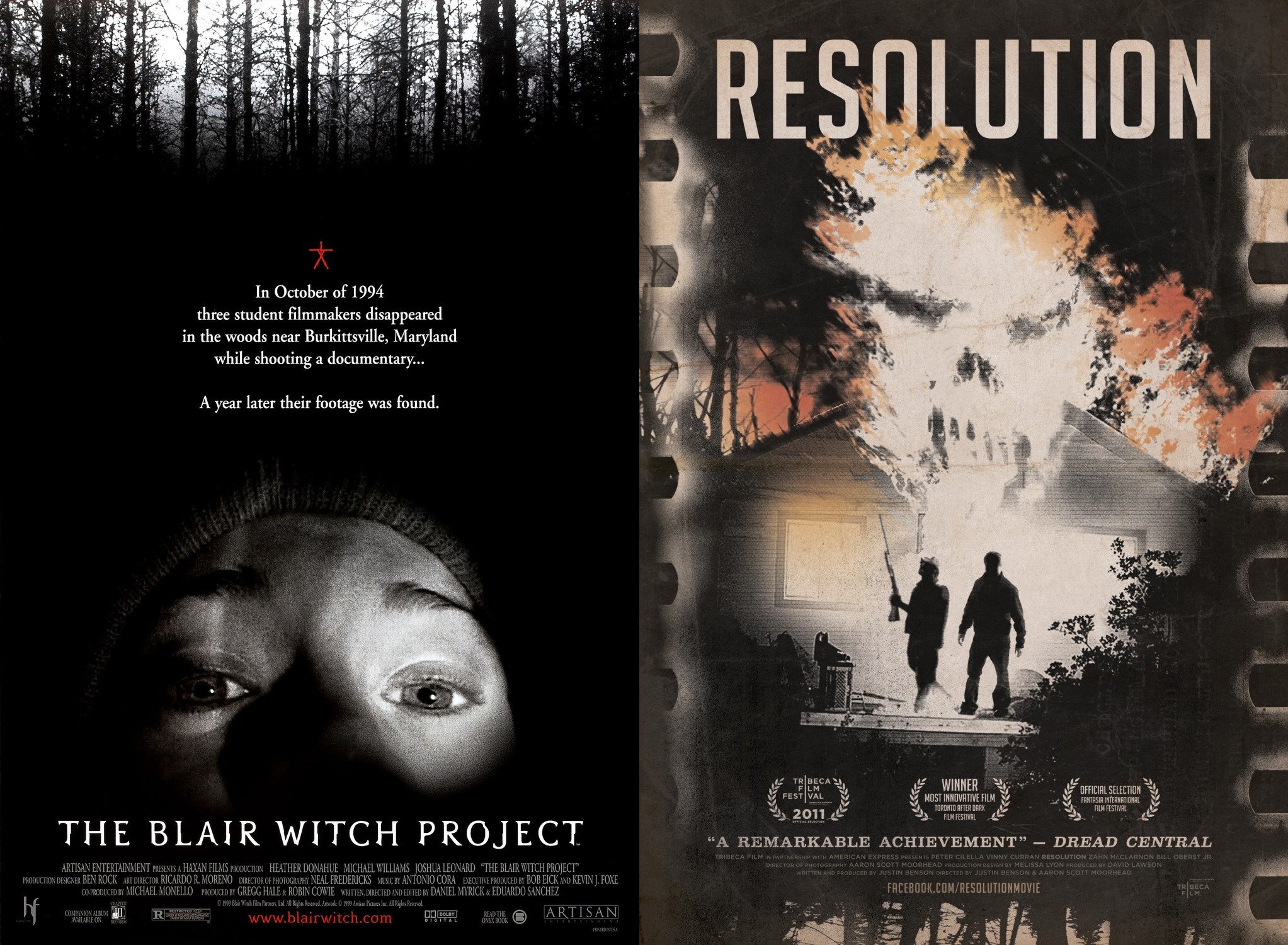Terror Never Dies: An Alternate October Calendar
October is coming to a close, and with it the most packed Hyperreal calendar that we've possibly ever had. Whether you attended every single screening or only managed to catch a few, we've got a way for you to continue the Hyperreal vibes straight on into November. For each movie we’ve screened, we’ve matched a movie with similar themes, vibes, or just another movie we think you’ll dig. They might make a good double feature, or at least a way to expand your favorite films list. Maybe, in another universe, this would've been the October lineup.
Brain Damage—Malignant
How can any movie live up to the go-for-broke energy of Frank Hennenlotter's Brain Damage with its Frasier Crane-esque, drug-dispensing worm and pec-washing bodybuilder? Well, James Wan's Malignant might be a good place to start. Certainly Wan was given a bigger budget for his gothic haunted body movie than Henenlotter got in pretty much his whole career combined, but both directors share a devilishly comedic sensibility and a gleeful attitude towards their unfortunate characters. Wan seems especially ready to cut loose with Malignant after years spent as Warner Bros.' go-to guy for middling-to-good action and horror movies, and the result is a wildly goofy, good time. If you've somehow managed to avoid the central twist of the film, I'd hate to deprive you of the pleasure of witnessing the absurd reveal for yourself, but suffice it to say, it shares more than just a sensibility with Brain Damage.
Check out my piece on the juicy pleasures of Brain Damage here and Baillee Perkins' review of Malignant here
Who Framed Roger Rabbit—Bubble Bath
There are plenty of qualities that define Who Framed Roger Rabbit: the unbelievably clean mixture of animated characters with live-action set pieces; incredible performances from Bob Hoskins, Christopher Llyod, and Kathleen Turner; the pitch-perfect neo-noir storyline turned comedy. But there's also Jessica Rabbit, which, let's face it, has defined the movie as much as, if not more than, any of these other fine qualities.
Bubble Bath, a Hungarian animated film from 1979, might be the only animated film to compete with the absurd horny energy of Jessica Rabbit, and it offers a masterclass in gorgeous animation as a bonus. The story follows a groom who finds himself getting cold feet on the day of his wedding, but the plot is entirely secondary to the free-flowing raunchy animation. Don't worry about the plot, just enjoy the vibes. Famously, the film was made by pulling animators from another Hungarian masterpiece of animation, Son of the White Mare, and while the latter is arguably a better movie, it's hard to fault them for jumping ship when Bubble Bath looks like it was so much fun to make.
Orlando—Emma.
If Orlando has you pining for more beautiful people dressed in layers and layers of beautiful clothing speaking to life the prose from a culturally significant female author, might I recommend 2020’s sleeper hit, Emma.? These two adaptations have striking parallels: films directed by women, based on novels written by women, about the titular women rebuking the traditional gender roles of their era. Soaked in eye candy and full of stifled passion, the most recent reimagination of Jane Austen’s beloved novel is the most fun you can have cheating on your English homework, with Anya Taylor-Joy and Mia Goth flexing their range and cementing themselves as two of the most exciting new(ish) actresses we’re seeing move into the mainstream.
It’s a safe assumption that this version of Emma would, given the choice, never fade, nor wither, nor grow old. Autumn de Wilde is clearly informed by her predecessors: she beautifully marries the formality of the 1996 release starring Gwyneth Paltrow with the levity (and stylized production design) of Clueless, which, of course, stars Alicia Silverstone as Cher. If only we had Orlando’s time travel element, so we could see other variations on Emma’s looks throughout history–and see even more incredible costumes designed by the queen of period drama, Alexandra Byrne. The maximalism of the film echoes that of Orlando, making this double feature an absolute feast for the eyes and heart. As Emma (kind of) says, “It’s such a happiness when good movies get together.”
-Kathryn Bailey
Elvira: Mistress of the Dark—The Love Witch
In terms of tone, Elvira: Mistress of the Dark is a lot closer to a Bugs Bunny short than any movie that would fit into a Halloween watchlist, but The Love Witch is probably the closest you're going to get to a live-action pairing. For starters, The Love Witch is a nearly one-woman passion project from writer/director/editor/composer/producer/set designer Anna Biller. Considering how much Cassandra Peterson fought to bring her unforgettable movie programmer character to the big screen, I think she'd respect the hustle. For another, both films feature a beautiful witchy woman moving to a small set-in-its-ways town where their unique gifts attract the attention and scorn of the townspeople in equal measure.
The Love Witch is also hilarious. It's not in the joke-a-minute style of Elvira, but there's a dry, campy pleasure to watching Anna Biller's witch character consecutively seduce, tire of, and ultimately dispose of, a series of male suitors. And for those of you whose favorite part of Halloween lies more on the "watching Hocus Pocus and eating candy corn" spectrum instead of watching something like "Gorehouse 3: The Bloodening," you'll be happy to hear that both movies are about as scary as walking into a particularly pungent antique store.
Hausu—The Happiness of the Katakuris
House/Hausu is an undeniably one-of-a-kind movie, marrying comedy and horror, goofy child logic with legitimately frightening surrealism, all filtered through Nobuhiko Obayashi's utterly unique visual style. It's safe to say there's quite literally nothing else like it. But, if you had to program a followup, you could do a lot worse than Takeshi Miike's The Happiness of the Katakuris. Miike is a hard director to pigeon hole. He's done films that are decidedly not for the squeamish like Audition or Ichi The Killer, but he's also made films like the child-friendly adaptation of the Phoenix Wright video game series. He's done over 100 films and shows no sign of slowing down. While I haven't seen anywhere close to his full filmography, The Happiness of the Katakuris makes it clear that Miike is a director willing to experiment with style.
Like House, it's a film about real-world issues like the possibility of redemption after being labeled a criminal or the difficulty of building a life for your family in the face of impending mortality. It's also, like House, largely absurd to try and offer a play by play of its comedic and horrifying pleasures. Happiness features a claymation murder, a zombie attack, and what seems to be the worlds' most attractive vacation destination for suicadal customers. Oh, and it's a musical. Did I mention that? While nothing can live up to the madcap energy of House, The Happiness of the Katakuris offers a catchy, pleasant attempt.
Check out my guide to enjoying House here
Return of the Living Dead—Repo Man
Punk's not dead—at least not in Return of the Living Dead, where a gang of punks face off against the only thing scarier than getting old: getting (Johnny) rotten as a corpse. With a soundtrack of notable punk bands and zombies that don't follow what we traditionally accept as "the rules" of how zombies should behave, Return is the rare studio film that legitimately can be called "punk."
Similarly, Repo Man which stars personal Ziah-fave Harry Dean Stanton and Emilio Estevez, has a deranged unpleasant energy to it that you can't look away from. There's a rhythm to the movie that seems so divergent from the way movies are normally paced that you have to give yourself over to it, accept that Estevez's flat delivery and the moral nastiness of being a repo man at all is part of the point. Throw in a similarly killer soundtrack from 80s punk bands, and you've got a great double feature. Get on board or get out of the car.
Dead Alive—Murder Party
While not as much of an exercise in bad taste as Peter Jackson's previous movie, uh… Bad Taste, Dead Alive is a teasing, mean little movie with an infamous lawnmower scene and possibly the only kung-fu fighting priest in the horror canon. Considering that Jackson went on to play a little bit nicer with the studio system with his Lord of the Rings movies and Beatles documentary, there must just be something about getting your kicks in when you start your career.
Though slightly more on the independent movie track, that seems to hold true for Jeremy Saulnier, who's made his mark in recent years with carefully considered commentaries on revenge like Blue Ruin and Hold The Dark. Sure, he also did the movie where Patrick Stewart plays a nazi (Green Room), but his sensibilities seem to lean more toward the carefully considered exploration of violence that leads to Sundance acclaim instead of midnight movie marathons. Maybe he got it all out of his system with his debut film Murder Party, which sees an extraordinarily hapless Halloween partygoer that ends up in, surprise surprise, a murder party held by bored tryhard art students. You can probably guess how it goes, but like with Dead Alive, the movie moves briskly enough that it never comes close to overstaying its welcome. And if you've ever spent time with the kind of art students featured in the film, you might find it scarier than anything else on this list.
Check out Justin Norris' piece on Peter Jackson's rise to the top here
The Faculty—Fright Night
Aliens invading your high school, the next door neighbor's a vampire… adults just don't understand, and pop culture is at turns both shockingly unhelpful and also the only guidebook you have to deal with the threat. Do I need to oversell this one? The Faculty is The Breakfast Club meets The Invasion of the Body Snatchers, combining the winking metatextual stylings of Kevin Williamson with the pleasingly off-kiler sensibilities of Robert Rodriguez. While Fright Night is relatively restrained compared to that 90s cult classic, it offers a similarly canny retelling of a story that you might've assumed was played out years before.
And while I've heard good things about the recent remake of Fright Night that starred a pretty obscenely stacked cast (Toni Collette, Anton Yelchin, David Tennant, Colin Farrel, Imogen Poots, et cet), I'm recommending the '80s original here. Roddy McDowell is excellent as Peter Vincent, a movie presenter who made his mark playing a famous vampire hunter years before, and Chris Sarandon has an incredibly off-putting nasty stepdad energy as the possibly vampiric next-door neighbor. You might be able to guess where this one's going, but the fun is in the journey, not the destination. Also remains a hall of fame entry in the "stop trying to have sex with me, I'm looking through the window" canon along with Rear Window.
Check out Jenni Kaye's short piece on The Faculty here
The Thing—Color out of Space
This isn't the point, but isn't it crazy that The Thing was so critically and commercially savaged on release? The merits of the film, from John Carpenter's masterful use of space, Ennio Morricone's sparse score, and, of course, the unbelievably excellent practical effects, seem obvious. But some movies just take time to hit with an audience. Was that the case with Color out of Space? It's hard to say… I remember the movie going over fairly well with critics and audiences, but it landed between two slightly more beloved Nicholas Cage performances (2018's Mandy and 2021's Pig) so maybe it was just overshadowed as people remembered that Cage is a legitimate talent.
Regardless, even though The Thing's source material isn't exactly Lovecraftian, it's hard not to see shades of that sensibility in Carpenter's film. Beyond the upsetting shape of the monster, there's an immediate pessimism and hopelessness that pervades the film. Throw in whatever explosive climax you want, add in Hollywood's most handsome badass in Kurt Russell, it won't stop the world that's coming. Color out of Space similarly showcases a pervading rot spreading deeper into a family's home until there's no chance of any escape. Turn to magic, lock the doors… the rot's coming from inside the house, and there's no escape. Perfect bummer double feature.
Killer Klowns from Outer Space—Terrorvision
The obvious choice for Killer Klowns from Outer Space might be Stephen King’s killer clown classic It (either the 2017 and 2019 movies or the 1990s miniseries). But if the draw of Killer Klowns is less the (k)lowns and more the prospect of delicious ‘80s schlock that twists the alien invasion genre into something truly out there, allow me to recommend TerrorVision (1986). Both Klowns and TerrorVision have the inauspicious honor of being named “so-bad-it’s-good,” and both have pretty killer (ha) theme songs liable to have you singing them days afterward. TerrorVision was co-written by Richard Band, known better for his contributions to horror distribution and production than horror screenwriting. His distribution company Empire International Pictures released 1985’s Re-Animator and Ghoulies, among a long list of other crate-digging cult faves.
Rather than the Big Top, TerrorVision focuses on the horror in modern television: our story begins with an alien waste disposal ship converting criminals and ne’er-do-wells into energy and beamed into outer space, only to be unwittingly picked up by the Putterman family’s brand-new satellite dish. Whatever moral stance the movie might be making on survivalists, aging swingers, horror variety shows, punk rock, metal, and the entertainment industry generally is obscure by the movie’s end, but it doesn’t matter–the movie knows you’re not watching for didacticism. You want to see the Puttermans’ youngest son raid his grandpa’s bunker and start blowing up some TVs, and you want to see a metalhead doofus Jon Gries (Uncle Rico from 2004’s Napoleon Dynamite). And on that, it can deliver.
-Sarah Schuster
Check out Bailey Moore's piece on Killer Klowns from Outer Space here
The Strangers—Hush
Home is where the heart is, so who wouldn't be scared if someone breaks in with a knife and a nasty attitude? While I think it's fair to say that Mike Flanagan is a bit too much of a softy to compete with the random act of violence that The Strangers trades on, his home invasion thriller Hush offers a slightly more high concept twist on the genre. It follows Maddie, a deaf-mute writer who has to fight off a nasty masked intruder after another murder leads him right to her door. Even with a restrained 80 minute runtime, it manages to squeeze out just about every possible twist you might be able to wring from that concept, leaving the audience as pleasantly spent as the character. It's as exhausting as The Strangers, and I do mean that as a compliment.
Re-Animator—The Washingtonians
I'll be honest with you, here. I don't necessarily think that The Washingtonians is a perfect double feature with Re-Animator, though it does offer a similar pleasure. And, based on the watch stats on Letterboxd, I think it's safe to say most people haven't seen it, and you absolutely should. The high concept is dynamite: What if George Washington was a cannibal? What if America was literally, instead of just metaphorically, built on butchering and consuming your "lessers?" Like Re-Animator, the best parts come from how pleasantly grotesque the filmmakers are able to stretch the basic concept. Safe to say Peter Medak is no Stuart Gordon (although he did direct some episodes of The Wire if you, like me, find that kind of fun), but he has the good sense to let his production designers go hog wild with the practical effects. Interestingly, Greg Nicotero, who worked on The Faculty and The Walking Dead pops up in the credits here. It might not be as good as Re-Animator, but it's a gooey aperitif that goes down smooth.
The Descent—Barbarian
Less is more, but not where The Descent is concerned. Neil Marshall's most famous film (and best by a mile, let's be fair) features at least three film-worthy ideas thrown into a nasty blender. You've got a woman recovering from the sudden passing of her family and a sneaking suspicion that her husband might not have been faithful prior to his death. You've got a group of women going caving in a claustrophobic environment where their past slights and connections can be, pardon the pun, brought to the surface. And, oh yeah, you've got weird mole monsters that are trying to kill them. There's a lot going on in the movie, and it undeniably works for the film's benefit, allowing the space for all sorts of readings about the various women and what the film might mean.
Similarly, Barbarian features both a literal descent and a subtle throughline of the difficulty women face surviving the patriarchy. Barbarian hits a lot of notes, and leaves plenty of room to read into the film as much or as little as you'd like. You can engage with the film's gestures toward gentrification, toxic inherited patriarchal values, and race, or you can just enjoy it as a horror movie with an absolutely killer premise. Like The Descent, it's a film that benefits a bit from the surprise genre twist halfway through, but both movies hold up as tense, claustrophobic thrillers even if you know what's coming up from below.
Check out Baillee Perkins' review of Barbarian here
The Blair Witch Project—Resolution
When we think about The Blair Witch Project, we think about the narrative around the film. The way the marketing for the film managed to hit such a convincing note that the film was actually real that millions of people genuinely believed it, even if they might say otherwise now. And it's true, it's one of the most amazing film hoaxes to happen outside of a Nathan For You episode, but The Blair Witch Project is also an incredible low-budget horror movie. It uses its shortcomings to gesture toward a cosmic and unknowable horror that simply wouldn't be possible if they'd had more money and more studio backing.
Similarly, Resolution is a movie that wouldn't be improved by a bigger budget. It's a stripped-down story of a man who kidnaps and holds his friend hostage in order to help him overcome his addiction. From there, reality starts to bend and break around them, and the film's ambition outpaces its budget in the best way. While filmmakers Justin Benson and Aaron Moorhead would return to the world of Resolution in a later film to make the meaning a bit more clear, I don't think it was the right move. Resolution is the kind of filmmaking debut that benefits from its shortcomings, and its budget issues only add to its delightful ambiguity.
Check out Katy Matz's piece on The Blair Witch Project here
Scream—Peeping Tom
Depending on how much of a Scream diehard you are, you might accuse me of lifting this comparison straight from the source – or one of its sequels to be exact. To that I say, “Fair enough. You got me.” But trivia aside, Michael Powell’s genre-defining descent into voyeuristic madness really did invent many of the tropes Scream lovingly sends up. Sixty years later it still stands as one of the most deeply misunderstood and genuinely horrific movies ever made, all without spilling a drop of blood – on camera at least.
Peeping Tom premiered in the U.K. just a few months before Psycho, earning its place in Scream lore as the “first” slasher film. And before you ask, director Michael Powell and Alfred Hitchcock had worked together and were friendly, but I bet Hitchcock wished he made Peeping Tom. Many of the quintessential slasher elements are present – shots from the killer’s point of view that make the audience culpable in their violence, a history of abuse and familial trauma underpinning the killer’s actions, a thematic focus on sexual repression and promiscuity, and a sympathetic, if naive, final girl. But writer Leo Marks twists the knife by making his killer far from a personification of evil. The heart of Peeping Tom is a Freudian cycle of abuse that’s portrayed in a brutally sympathetic way by Carl Boehm, no doubt a large part of why British critics so deeply misunderstood and reviled the film. If you think John Carpenter was done dirty, just wait until you see Peeping Tom, the film that killed its director’s career then went on to be considered one of the best in horror history. Powell lived to see the critical reassessment, but the damage was already done to his career. Hitchcock learned his lesson and didn't host press screenings for Psycho.
-Craig Zirpolo



















Writer, guilty pleasure enthusiast, karaoke zealot. @kathkathkath for pictures of flowers.